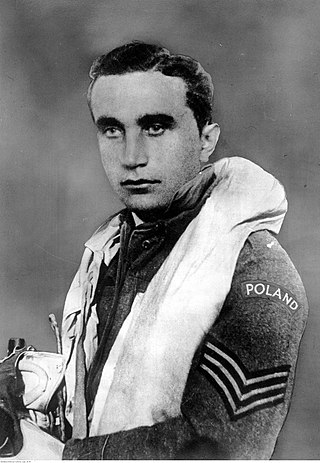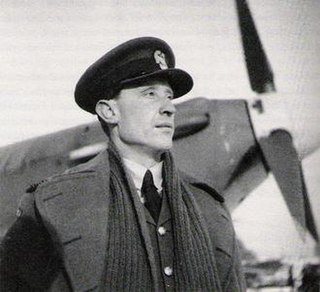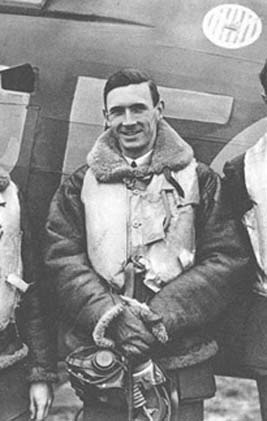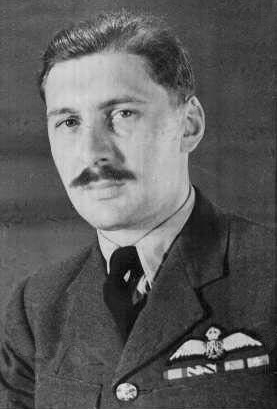Related Research Articles

The Distinguished Flying Cross (DFC) is the third-level military decoration awarded to officers, and since 1993 to other ranks, of the United Kingdom's Royal Air Force and other services, and formerly to officers of other Commonwealth countries, for "an act or acts of valour, courage or devotion to duty whilst flying in active operations against the enemy".

Josef František, was a Czechoslovak fighter pilot and Second World War fighter ace who flew for the air forces of Czechoslovakia, Poland, France, and the United Kingdom. He was the highest-scoring non-British Allied ace in the Battle of Britain, with 17 confirmed victories and one probable, all gained in a period of four weeks in September 1940.

No. 303 Squadron RAF, also known as the 303rd "Tadeusz Kościuszko Warsaw" Fighter Squadron, was one of two Polish squadrons that fought during the Battle of Britain along with No. 302 Squadron, of 16 total Polish squadrons during the Second World War. Flying Hawker Hurricanes, the squadron claimed the largest number of aircraft shot down of the 66 Allied fighter squadrons engaged in the Battle of Britain, even though it joined the fray two months after the battle had begun.

Witold Urbanowicz was a Polish fighter ace of the Second World War. According to the official record, Witold Urbanowicz was the second highest-scoring Polish fighter ace, with 17 confirmed wartime kills and 1 probable, not counting his pre-war victory. He was awarded with several decorations, among others the Virtuti Militari and British Distinguished Flying Cross. He also published several books of memoirs.

Group Captain John Alexander Kent,, nicknamed "Kentski" by his Polish comrades, was a Canadian fighter ace flying in the Royal Air Force during the Second World War. Considered one of the best young squadron leaders of the war, he went on to a distinguished postwar career before entering the aviation industry.

Zygmunt Witymir Bieńkowski was a Polish pilot and a writer of many articles and poems. His 303 squadron diary is held in the Polish Museum and Sikorski Institute in London.

James Joseph "Orange" O'Meara, was a Royal Air Force officer and fighter pilot of the Second World War. He became a flying ace during the Battle of Britain while flying the Supermarine Spitfire, and by war's end was credited with 11 kills, two shared victories, one unconfirmed destroyed, four probables, 11 damaged and one shared damaged.

Wing Commander Robert Roland Stanford Tuck, was a British fighter pilot, flying ace and test pilot. Tuck joined the Royal Air Force (RAF) in 1935 and first engaged in combat during the Battle of France, over Dunkirk, claiming his first victories. In September 1940 he was promoted to squadron leader and commanded a Hawker Hurricane squadron. In 1941–1942, Tuck participated in fighter sweeps over northern France. On 28 January 1942, he was hit by anti-aircraft fire, was forced to land in France, and was taken prisoner. At the time of his capture, Tuck had claimed 29 enemy aircraft destroyed, two shared destroyed, six probably destroyed, six damaged and one shared damaged.
Brian Carbury, was a New Zealand fighter ace of the Royal Air Force (RAF) during the Second World War. He was officially credited with destroying 15+1⁄2 enemy aircraft.

Air Commodore Peter Malam "Pete" Brothers, was a Royal Air Force fighter pilot and flying ace of World War II. Brothers was credited with 16 aerial victories, 10 of which he achieved during the Battle of Britain.

Wing Commander Antoni (Toni) Głowacki DFC, DFM, was a Polish Second World War fighter pilot flying with Polish Squadrons attached to the Royal Air Force, who is notable for shooting down five German aircraft on 24 August 1940 during the Battle of Britain, becoming one of only four pilots who gained "ace-in-a-day" status during that battle, the others being New Zealander Brian Carbury, Englishman Ronald Hamlyn and Scot Archie McKellar.
Wing Commander John Robert Baldwin, was a Royal Air Force fighter pilot and the top scoring fighter ace flying the Hawker Typhoon exclusively during the Second World War. He went missing during secondment service with the United States Air Force in the Korean War and was presumed killed.

Zdzisław Karol Henneberg VM, DFC, KZ***, CdeG was a Polish airman who flew with the Royal Air Force during the Battle of Britain and a flying ace of the Second World War.
Air Vice Marshal Edward Dixon Crew, was a Royal Air Force officer and a nightfighter ace of the Second World War. He shot down 15 enemy aircraft and was one of the top-scoring aces against the V-1 flying bomb.
Flight Lieutenant Cecil Frederick "Jimmy" Rawnsley was a Royal Air Force night fighter observer radar operator and gunner during the Second World War. He flew many of his sorties with John "Cat's Eyes" Cunningham who was credited with 20 kills, of which 19 were claimed at night, and 17 of which were achieved with Rawnsley.
Air Commodore Roy Gilbert Dutton, was a Royal Air Force officer and decorated flying ace. He flew Hurricanes during the Second World War and was credited with 19 confirmed aerial victories.
Ludwik Paszkiewicz DFC was a Polish fighter ace of the Polish Air Force in World War II with 6 confirmed kills.
Osgood Philip Villiers "Pedro" Hanbury, was a Royal Air Force flying ace of the Second World War. He had scored 11 victories before he was killed in action in 1943.

Peter William Olber "Boy" Mould, was a Royal Air Force fighter pilot and flying ace of the Second World War.

Hugo Throssell Armstrong was an Australian flying ace of the Royal Australian Air Force (RAAF) during the Second World War. He was credited with at least ten aerial victories.
References
- 1 2 3 "No. 34978". The London Gazette . 25 October 1940. p. 6192.
- 1 2 3 "No. 34958". The London Gazette . 1 October 1940. p. 5789.
- 1 2 3 4 5 6 7 8 9 10 "Wing Commander Ronald Kellett". The Times. No. 66732. London. 30 November 1998. p. 25.
- ↑ "No. 34221". The London Gazette . 19 November 1935. p. 7337.
- 1 2 "No. 35060". The London Gazette . 31 January 1941. p. 3254.
- ↑ "No. 37724". The London Gazette (Supplement). 13 September 1946. p. 4622.
- ↑ "No. 40144". The London Gazette (Supplement). 9 April 1954. p. 2197.